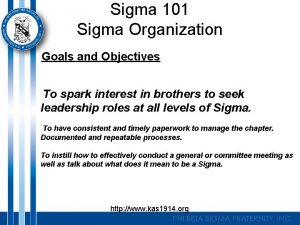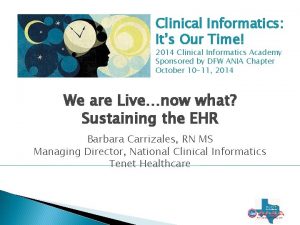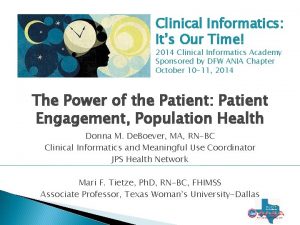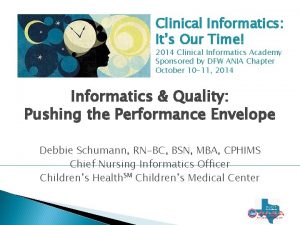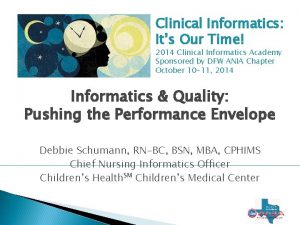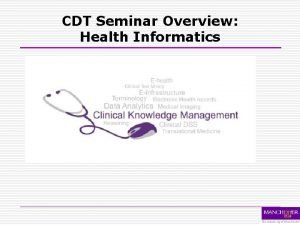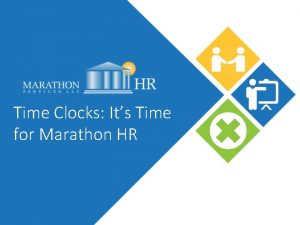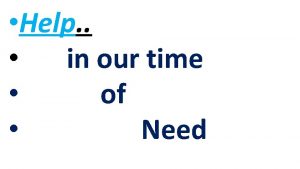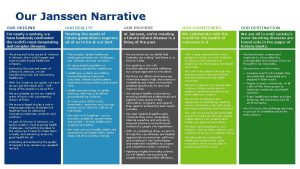Clinical Informatics Its Our Time 2014 Clinical Informatics





























- Slides: 29

Clinical Informatics: It’s Our Time! 2014 Clinical Informatics Academy Sponsored by DFW ANIA Chapter October 10 -11, 2014 The Clinical Informatics Leader: A Behavioral Analysis Dorothy Du. Sold, MA, CPHIMS Senior Director Adoption & Sustainment Tenet Healthcare 1

Conflict of Interest Disclosure Dorothy Du. Sold, MA, CPHIMS has no real or apparent conflicts of interest to report. 2

Session Objectives � Learn why behavioral profiling for clinical informatics leaders was a need at Tenet � Learn how Tenet developed the behavioral profile � Learn what makes up the behavioral DNA of effective Tenet clinical informatics leaders � Learn ways to use the behavioral profile 3

Why Behavioral Profiling? Session Objective #1 4

Tenet Spans 16 States in Many Settings Michigan 8 Hospitals 9 Outpatient Pro. Care Tennessee Illinois 12 Hospitals 36 Outpatient Golden State Health Plan 2 Hospitals 6 Outpatient 4 Hospitals 4 Outpatient Chicago Health Plan 2 Hospitals 3 Outpatient N. Carolina 2 Hospitals 3 Outpatient 2 Hospitals 4 Outpatient Arizona S. Carolina 5 Hospitals 10 Outpatient Georgia New Mexico 5 Hospitals 15 Outpatient 2 Outpatient Alabama Texas 197 Outpatient Centers 6 Health Plans 3 Hospitals 4 Outpatient Pennsylvania Missouri 80 Hospitals 4 Hospitals Massachusetts California 6 Hospitals 4 Outpatient Abrazo Advantage Health Plan Connecticut (LOI) 19 Hospitals 63 Outpatient Valley Baptist Health Plan 1 Hospital 5 Outpatient Mississippi Florida 10 Hospitals 28 Outpatient 1 Outpatient 5

Clinical Informatics Structure at Tenet � Three levels of Clinical Informatics (CI) National Clinical Informatics Managing Director Regional Clinical Informatics Director Hospital Clinical Informatics Director 1 1 Direct Regional Clinical Informatics Director Hospital Clinical Informatics Director 1 report to hospital Chief Nursing Officer 6

Clinical Informatics Role at Tenet � Hospital director-level position � Strategic to the successful adoption and sustainment of the EHR � Primary role is to serve as a change agent ◦ Must be able to move people out of their comfort zones and challenge the status quo ◦ Promotes health system-wide standards, not automation of hospital-specific practices � Represents all departments, not just nursing � Must be influential, articulate, credible, respected, fair-minded 7

The Cause for Action � Identify the right individuals to fill the role � Improve CI effectiveness � Evolve the organization’s perception of the role � Reduce turnover � Enhance the organization’s ability to promote standardization, implement rapid changes, and develop the culture needed to sustain the EHR environment 8

How Was the Profile Developed? Session Objective #2 9

Step 1: Identify the population � 30 Tenet-employed clinical informatics leaders from hospitals in 12 states (subset of group pictured below) � Over 6 months tenure in the position 10

Step #2: Assess the population (1 of 2) � CI population completed an assessment used as part of hiring process for leaders � CI Skills assessment ◦ Managers rated CIs on the Tenet CI Skills Assessment Tool ◦ Measures “user”, “modifier”, “innovator” competencies Assessment Areas: • Experience and background • Leadership and collaboration • Effective communication • Change management • Organizational readiness • Value realization • Work ethic and integrity 11

Step #2: Assess the population (2 of 2) � Behavioral assessment ◦ Assessment firm interviewed managers to identify the traits they considered important to the CIs effectiveness ◦ An assessment was completed by the manager of each CI to rate the CIs on these traits � Forced ranking ◦ CI population was ranked from highest to lowest performer based on the skills and behavioral assessments 12

Step #3: Develop the Behavioral Profile � The assessment firm performed analysis of all data to determine the behavioral DNA of our top performers ◦ General assessment results for each CI ◦ Manager assessment results for each CI ◦ Forced ranking � Analyzed 38 attributes � Determined most predictive attributes for position fit and assigned weights � Identified 8 significant attributes 13

What is the Behavioral DNA of Successful CI Leaders? Session Objective #3 14

Interpretation Behavioral attribute identified as relevant to the effective CI leader Weight: Degree of relevance of the attribute Note: Above 4 is relevant; 15 is an extremely high weight Description of the successful behavior Continuum: The ideal placement and range on the scale of behavioral extremes 15

#1 – Realistic Thinking Effective Clinical Informatics Leaders: � Make decisions based on reliable facts but also considers other factors such as ◦ The organization’s capacity to deal with change ◦ Environmental constraints ◦ Clinical system functionality ◦ Resource capabilities ◦ Competing initiatives and priorities 16

#2 – Organizational Structure Effective Clinical Informatics Leaders: � Can exert influence at all levels of the organization ◦ C-Suite ◦ Department directors and physician department chairs ◦ Managers and supervisors ◦ Super users ◦ End users � Do not need a rigid structure 17

#3 – Acceptance of Authority Effective Clinical Informatics Leaders: � Will respectfully challenge the status quo when perceived for the better good � Will support a clinical system standard but must believe in it (using realistic thinking!) ◦ This is hard when supporting standards across a large organization 18

#4 – Organizational Skills Effective Clinical Informatics Leaders: � Can make organization out of disorganization; leaves detailed organizational tasks to others � Helps others see the big picture and directs them to do the minutia to follow through on what needs to be done � Delegates effectively to others 19

#5 – Job Atmosphere Effective Clinical Informatics Leaders: � Are effective in both informal (i. e. the break room) and formal (the board room) settings � Are flexible and can adapt to a wide range of professional environments to establish a rapport with the audience 20

#6 – Conscientiousness Effective Clinical Informatics Leaders: � Balance quality with timeliness � Know when “B” work is good enough � Do not sweat the small stuff � Hold others accountable 21

#7 – Analytical Effective Clinical Informatics Leaders: � Analyze facts but also considers the people factors ◦ Mid range between artists and accountants � Use data to change behavior ◦ Do not stay behind a desk creating spreadsheets ◦ Make end users understand how their use of the EHR produces analytics that allow comparative analysis of outcomes 22

#8 – People Orientation Effective Clinical Informatics Leaders: � Are tolerant of others’ viewpoints � Respect and encourage discussion � Are not critical, rigid, and faultfinding � Are supportive of others, yet able to drive to a decision � More outgoing in nature as opposed to being introverted 23

How Can You Use the Profile? Session Objective #4 24

Recruiting � CI leader candidates complete the behavioral assessment during the interview process � Assessment results are compared to the CI Behavioral Profile � Behavioral profile matches are considered along with other factors in the hiring decision 25

Skills Development � Develop CI education sessions to strengthen desired characteristics and mitigate highrisk behaviors � Address behavioral skills in individual CI development plans � Provide education on interaction across different behavioral styles 26

Recap In this session, did you: � Learn why behavioral profiling for clinical informatics leaders was a need at Tenet? � Learn how Tenet developed the behavioral profile? � Learn what makes up the behavioral DNA of effective Tenet clinical informatics leaders? � Learn ways to use the behavioral profile? 27

Contact Information � Dorothy Du. Sold, MA, CPHIMS ◦ Senior Director Adoption & Sustainment ◦ Tenet Healthcare ◦ dorothy. dusold@tenethealth. com 28

29
 Elapsed time
Elapsed time Thinking affects our language, which then affects our:
Thinking affects our language, which then affects our: Our census our future
Our census our future Bernadette farrell christ, be our light
Bernadette farrell christ, be our light Our life is what our thoughts make it
Our life is what our thoughts make it We bow our hearts
We bow our hearts Our census our future
Our census our future Our life is what our thoughts make it
Our life is what our thoughts make it Money madness poem explanation
Money madness poem explanation Our awareness of ourselves and our environment
Our awareness of ourselves and our environment Our awareness of ourselves and our environment.
Our awareness of ourselves and our environment. God our father christ our brother
God our father christ our brother Our future is in our hands quotes
Our future is in our hands quotes Our awareness of ourselves and our environment.
Our awareness of ourselves and our environment. Our awareness of ourselves and our environment is called
Our awareness of ourselves and our environment is called Sigma objectives
Sigma objectives Its our party
Its our party Form of emigree
Form of emigree When a train increases its velocity, its momentum
When a train increases its velocity, its momentum Sunny windy cloudy rainy
Sunny windy cloudy rainy If its a square it's a sonnet summary
If its a square it's a sonnet summary Its halloween its halloween the moon is full and bright
Its halloween its halloween the moon is full and bright Its not easy but its worth it
Its not easy but its worth it Paradox of our time
Paradox of our time Setting in time
Setting in time Time speak
Time speak Nor1log
Nor1log Its rhyme time
Its rhyme time Its time to start running
Its time to start running Its dude time
Its dude time















